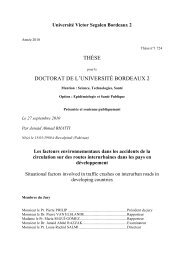Télécharger le texte intégral - ISPED-Enseignement à distance
Télécharger le texte intégral - ISPED-Enseignement à distance
Télécharger le texte intégral - ISPED-Enseignement à distance
- No tags were found...
Create successful ePaper yourself
Turn your PDF publications into a flip-book with our unique Google optimized e-Paper software.
Modè<strong>le</strong> nonlinéaire <strong>à</strong> processus latent 701018 Biometrics, December 2006were free of dementia at the first follow-up and with at <strong>le</strong>astone measurement for each of four (K = 4) psychometric testsduring the follow-up.The four tests considered are the Mini Mental State Examination(k = 1), the Isaacs Set Test (k = 2), the BentonVisual Retention Test (k = 3), and the Digit Symbol SubstitutionTest of Wechs<strong>le</strong>r (k = 4). The Mini Mental StateExamination (MMSE) evaluates various dimensions of cognition(memory, calculation, orientation in time and space,language, and word registration); it ranges from 0 to 30 andthe distribution is strongly skewed to <strong>le</strong>ft with a ceiling effect.The Isaacs Set Test (IST) shortened at 15 seconds evaluatesverbal fluency accounting for the speed of execution: subjectshave to give a list of words (with a maximum of 10 words)in four semantic categories. It ranges from 0 to 40 and thedistribution is close to a Gaussian distribution with a litt<strong>le</strong>heavier <strong>le</strong>ft tail. The Benton Visual Retention Test (BVRT)evaluates visual memory: subjects have to recognize 15 geometricfigures among four proposals. It ranges from 0 to 15and the distribution is skewed to <strong>le</strong>ft but the ceiling effect is<strong>le</strong>ss strong than for the MMSE. The Digit Symbol SubstitutionTest of Wechs<strong>le</strong>r (DSSTW) evaluates attention: given atab<strong>le</strong> of correspondence between symbols and numbers, subjectshave to translate a sequence of 90 numbers into the rightsequence of symbols. In the samp<strong>le</strong>, it ranges from 0 to 76and the distribution is approximately Gaussian. For the fourtests, low values indicate a more severe impairment. In theanalysis, resca<strong>le</strong>d scores computed as the value of the testplus 0.5 divided by 1 plus the range of the observed valuesproduced values in the open interval (0, 1) and were consideredas continuous. For the DSSTW, the observed range was76 whi<strong>le</strong> the maximum possib<strong>le</strong> value was 90. An additionalanalysis performed using 90 instead of 76 for rescaling <strong>le</strong>d tonearly identical results. More generally, we think it is betterto use the observed range for rescaling to avoid interpretingthe relationship between the score and the latent process onan unobserved range of values.The apoE genotype was col<strong>le</strong>cted on a subsamp<strong>le</strong> of thePAQUID cohort, so the samp<strong>le</strong> used in the analysis consistedof 563 subjects having between 1 and 6 measurements per test(median = 4). The covariates included in the analysis weregender, educational <strong>le</strong>vel (graduated from primary school vs.lower <strong>le</strong>vel), and the apoE genotype (ɛ4 carrier vs. ɛ4 noncarrier).The time sca<strong>le</strong> was the age minus 65 years per 10 years(t =age − 6510).5.2 Comparison of the Fit for the Various Familiesof TransformationsWe first assumed that the latent cognition was a quadraticfunction of time without covariates in expression (1) and withoutany contrast in expression (2). Using this model, we comparedthe fit for the beta CDF, the linear transformation, thecombination of a linear transformation and the logit transformation,and the Weibull CDF. According to the Akaikeinformation criterion (AIC) (see Tab<strong>le</strong> 1), the beta transformationgave a markedly better fit.5.3 Estimations of the Model with the Beta TransformationUsing the beta transformation, the best fitting model includeda quadratic function of time with three random coefficientsand the three covariates (educational <strong>le</strong>vel, gender, and apoETab<strong>le</strong> 1Fit of the data for various transformations in the modelwithout covariates and a quadratic function of timeNumber of LogFamily of transformation parameters likelihood AICLinear transformation 20 −21584.1 43208.2Beta CDF 22 −20387.1 40818.2Logit + 20 −20876.4 41792.8linear transformationWeibull CDF 22 −20654.7 41353.4genotype) in the model for the latent process. As it was suspectedthat ability in visual memory, verbal fluency, and attentioncould be differently associated with gender and educational<strong>le</strong>vel, we also included contrasts between tests for thesecovariates. Interactions between apoE genotype and time variab<strong>le</strong>swere also included in the latent process. Interactionsbetween gender and time and between educational <strong>le</strong>vel andtime were not found to be significant and did not confound theassociation between apoE and cognitive evolution. Thus theywere excluded from the final model. Estimates of the fixedeffect parameters in the final model are presented in Tab<strong>le</strong> 2.Tab<strong>le</strong> 2Estimates of the fixed effect parameters in the best model withthe beta transformation (log likelihood = −19715.55; numberof parameters = 36; AIC = 39503.1)Parameter Estimate SEIntercept: μ 0 0.538 0.013Linear slope: μ 1 −0.0044 0.0098Quadratic slope: μ 2 −0.0291 0.0040Gender a −0.0062 0.0071Education b 0.111 0.0088apoE c 0.0070 0.0096apoE c × t 2 −0.0103 0.0033Contrasts on gender a (p = 0.027 d )On MMSE (k =1) −0.0095 0.0052On IST (k =2) −0.0052 0.0062On BVRT (k = 3) 0.0148 0.0052On DSSTW (k =4) −0.0001 0.0047Contrasts on education b (p = 0.136 d )On MMSE (k =1) −0.0117 0.0061On IST (k = 2) 0.0108 0.0070On BVRT (k =3) −0.0044 0.0062On DSSTW (k = 4) 0.0053 0.0058η 11 (MMSE) 1.409 0.097η 21 (MMSE) 0.401 0.018η 12 (IST) 0.952 0.064η 22 (IST) 0.697 0.041η 13 (BVRT) 0.887 0.062η 23 (BVRT) 0.569 0.032η 14 (DSSTW) 0.477 0.027η 24 (DSSTW) 0.838 0.057a Reference: fema<strong>le</strong>.b Reference: not graduated from primary school.c Reference: ɛ4 noncarrier.d Likelihood ratio test for the contrast variab<strong>le</strong>s (X 2 with 3 degreesof freedom).
















